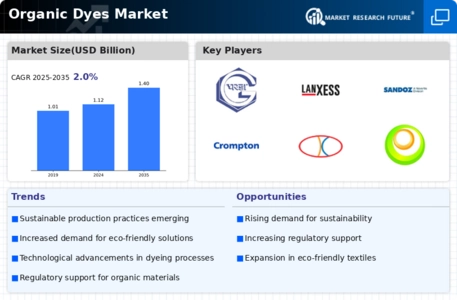Regulatory Support
Regulatory frameworks across various countries are increasingly favoring the use of organic dyes, thereby bolstering the Global Organic Dyes Market Industry. Governments are implementing stricter regulations on synthetic dyes due to their adverse environmental impacts. For instance, the European Union has introduced directives that limit the use of hazardous substances in products, encouraging manufacturers to transition to organic alternatives. This regulatory support is expected to enhance market growth, with projections indicating a market value of 1.4 USD Billion by 2035. As compliance becomes essential, companies are likely to invest in organic dye solutions, further driving market expansion.
Sustainability Trends
The Global Organic Dyes Market Industry is experiencing a notable shift towards sustainability, driven by increasing consumer awareness regarding environmental issues. As industries seek to reduce their carbon footprint, organic dyes, which are derived from natural sources, are gaining traction. This trend is reflected in the projected market value of 1.12 USD Billion in 2024, indicating a growing preference for eco-friendly alternatives. Companies are increasingly adopting organic dyes in textiles, cosmetics, and food industries, aligning with global sustainability goals. This shift not only caters to consumer demand but also complies with stringent regulations aimed at reducing harmful chemical usage.
Market Growth Projections
The Global Organic Dyes Market Industry is poised for substantial growth, with projections indicating a market value of 1.12 USD Billion in 2024 and an anticipated increase to 1.4 USD Billion by 2035. This growth trajectory reflects a compound annual growth rate (CAGR) of 2.03% from 2025 to 2035. Factors contributing to this growth include rising consumer awareness of environmental issues, regulatory support for sustainable practices, and technological advancements in dye production. As industries continue to shift towards organic alternatives, the market is likely to expand, presenting opportunities for innovation and investment.
Technological Advancements
Technological innovations play a crucial role in the Global Organic Dyes Market Industry by enhancing the efficiency and effectiveness of organic dye production. Advances in extraction and processing techniques allow for higher yields and improved colorfastness, making organic dyes more competitive with synthetic options. For example, new methods of dye extraction from plants have been developed, which not only increase dye yield but also reduce waste. As a result, the market is projected to grow at a CAGR of 2.03% from 2025 to 2035, reflecting the potential of technology to transform organic dye applications across various sectors.
Consumer Demand for Natural Products
There is a growing consumer demand for natural and organic products, significantly impacting the Global Organic Dyes Market Industry. As health-conscious consumers become more aware of the potential risks associated with synthetic dyes, they are increasingly opting for products dyed with organic alternatives. This trend is particularly evident in the textile and food industries, where organic dyes are perceived as safer and more environmentally friendly. The market's projected growth to 1.12 USD Billion in 2024 underscores this shift in consumer preferences. Companies that adapt to these demands by incorporating organic dyes into their products are likely to gain a competitive edge.
Market Diversification Opportunities
The Global Organic Dyes Market Industry presents numerous diversification opportunities across various sectors, including textiles, food, and cosmetics. As industries seek to differentiate their products, organic dyes offer unique color profiles and branding potential. For instance, the textile industry is increasingly utilizing organic dyes to appeal to eco-conscious consumers, while the food sector is adopting them for natural coloring. This diversification is expected to contribute to the market's growth, with projections indicating a value of 1.4 USD Billion by 2035. Companies that explore these opportunities may find new revenue streams and enhance their market presence.




















Leave a Comment